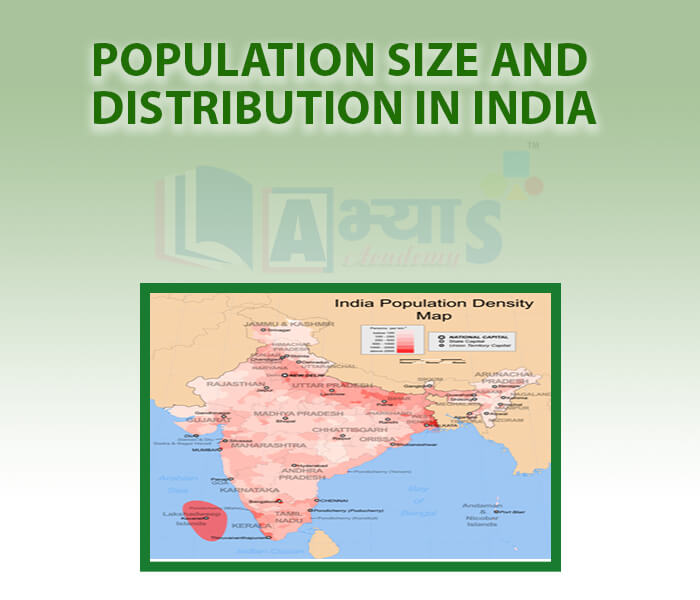Population Size and Distribution in India













Population Size and Distribution in India
Population size and distribution: The arrangement or a spread of people of a country in different places is Population distribution. Size of population and its distribution can be studied under two heads: ONE population size and distribution by numbers and other is population distribution by density.
India’s Population Size and Distribution by Numbers: As per 2011 Census, population of India stood at 1,210 million, which is 17.5% total world population. It is unevenly distributed over the various states, with Uttar Pradesh having the highest population (199 million accounts for about 16.49 per cent of the country’s population) and Sikkim the lowest population (0.6 million accounts for about 0.05 per cent of the country’s population). Among Union Territories, Delhi has the highest (16.75 million) and Lakshadweep the lowest (64,429) population.
India’s Population Distribution by Density: The uneven population distribution can be better judged by the population density in the various states. The number of people living per unit area (sq. km) in an area (state or country) is called population density of that area. India’s is one of the most densely populated countries in the world. After Bangladesh and Japan, it is the third most densely populated country. India’s population density in 2001 was 324 persons per sq km (this increased to 382 persons per sq km in the 2011 Census), with West Bengal having the highest density of 904 persons per sq km and Arunachal Pradesh the lowest with only 13 persons per sq. km. According to 2011 Census, Bihar has the highest population density 1,102 persons per sq km and Arunachal Pradesh having the lowest population density of 17 persons per sq km. On the basis of population density whole country is divided into three regions:
Students / Parents Reviews [10]
My experience with Abhyas academy is very good. I did not think that my every subject coming here will be so strong. The main thing is that the online tests had made me learn here more things.

Hiya Gupta
8thAbhyas is a complete education Institute. Here extreme care is taken by teacher with the help of regular exam. Extra classes also conducted by the institute, if the student is weak.

Om Umang
10thOne of the best institutes to develope a child interest in studies.Provides SST and English knowledge also unlike other institutes. Teachers are co operative and friendly online tests andPPT develope practical knowledge also.

Aman Kumar Shrivastava
10thMy experience with Abhyas is very good. I have learnt many things here like vedic maths and reasoning also. Teachers here first take our doubts and then there are assignments to verify our weak points.

Shivam Rana
7thBeing a parent, I saw my daughter improvement in her studies by seeing a good result in all day to day compititive exam TMO, NSO, IEO etc and as well as studies. I have got a fruitful result from my daughter.

Prisha Gupta
8thIt has a great methodology. Students here can get analysis to their test quickly.We can learn easily through PPTs and the testing methods are good. We know that where we have to practice

Barkha Arora
10thI have spent a wonderful time in Abhyas academy. It has made my reasoning more apt, English more stronger and Maths an interesting subject for me. It has given me a habbit of self studying

Yatharthi Sharma
10thA marvelous experience with Abhyas. I am glad to share that my ward has achieved more than enough at the Ambala ABHYAS centre. Years have passed on and more and more he has gained. May the centre flourish and develop day by day by the grace of God.

Archit Segal
7thAbout Abhyas metholodology the teachers are very nice and hardworking toward students.The Centre Head Mrs Anu Sethi is also a brilliant teacher.Abhyas has taught me how to overcome problems and has always taken my doubts and suppoeted me.

Shreya Shrivastava
8thMy experience was very good with Abhyas academy. I am studying here from 6th class and I am satisfied by its results in my life. I improved a lot here ahead of school syllabus.
